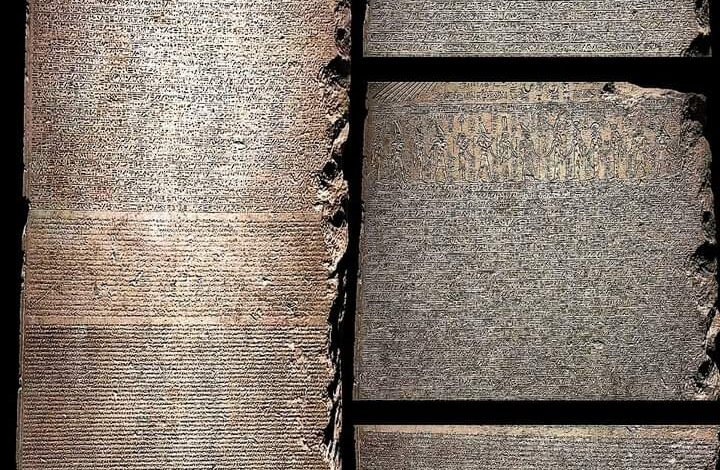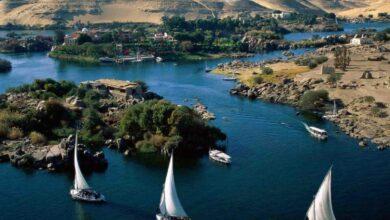لوحة كانوب هي أهم قطعة أثرية في المتحف المصري بالقاهرة.
من القاهره كتب . الباحث في الآثار المصري أ/ محسن شعراوي

لوحة كانوب هي أهم قطعة أثرية في المتحف المصري بالقاهرة. إنه لوح حجري كبير مستطيل يبلغ ارتفاعه حوالي 2 متر وعرضه 1.5 متر. تم اكتشاف اللوحة في عام 1902 في مدينة كوم الحيتان ، التي تقع في دلتا النيل في مصر.
The Canopus Stela is the most important artifact in the Egyptian Museum in Cairo. It is a large, rectangular stone slab that is approximately 2 meters high and 1.5 meters wide. The stela was discovered in 1902 in the town of Kom el-Hetan, which is located in the Nile Delta in Egypt.
وهذه اللوحة على نص باللغة المصرية القديمة يؤكد إنشاء أول تقويم شمسي في العالم. استند هذا التقويم إلى ملاحظة أن الشمس تستغرق 365يوما للدوران حول الأرض. لوحة كانوب هي أقدم دليل على قيد الحياة لهذا التقويم ، وهو أساس تقويمنا الحديث.
The stela is important because it contains a text in ancient Egyptian that confirms the establishment of the first solar calendar in the world. This calendar was based on the observation that the sun takes 365.2422 days to orbit the Earth. The Canopus Stela is the earliest surviving evidence of this calendar, which is the basis of our modern calendar.
وصف اللوحة أعلى اللوحة التي تأخذ الشكل شبة المستدير , تم نقش منظر لقرص الشمس المجنح , يتدلى من الشمس ثعبان كوبرا , تحت هذا المنظر يوجد نقش لعدد من الأرباب و الربات الأسطوريين و الأسطوريات ذوى الصبغة المصرية القديمة ثم نجد تحت هذا المنظر عدداً من السطور المنقوشة مقسمة إلي 26 سطراً من الرموز الهيروغليفية و تليها 20 سطراً من الكتابات الديموطيقية ( لغة العامة و الشعب و هي كتابة سريعة و مختصرة منبثقة من الهيروغليفية ) , و أخيراً النص الأكبر باللغة اليونانية و الذي يصل عدد سطوره إلي 64 سطراً .
The Kom el-Hetan tablet is a large, rectangular stone slab that is approximately 2 meters high and 1.5 meters wide. The top of the tablet is carved in the shape of a rounded arch. In the center of the arch is a winged solar disk, from which a cobra snake hangs. Below the solar disk is a scene of several mythological gods and goddesses.
Below the scene of the gods and goddesses is a series of inscriptions. The first 26 lines are written in hieroglyphics, the ancient Egyptian writing system. The next 20 lines are written in Demotic, a simplified form of hieroglyphics that was used by the common people. The final 64 lines are written in Greek.
حيث أتى هذا النص بحقيقتين
الأولى ” أن الملك أصدر أوامره بأن يتم نقش هذا البيان علي حجر أو صفائح من البرونز باللغتين الهيروغليفية و اليونانية و تعرض للعامة بالمعابد ”
و هذه الجملة في النص هي إثبات واضح لحقيقة تاريخية كانت غائبة و هي أنه يوجد هناك أكثر من حجر واحد و نص واحد مترجم و مفسر بالطرق الثلاثة المكتوبة و المنقوشة , لذا من الممكن أن نجزم بأنه يوجد عدد أخر من اللوحات و الصفائح التي لم تكتشف بعد مدفونة فيأرضية المعابد و لم يتم الكشف عنها .
The text you provided contains two facts. The first is that the king ordered the statement to be inscribed on a stone or bronze plates in the hieroglyphic and Greek languages and displayed to the public in the temples. This sentence in the text is clear evidence of a historical fact that was missing, which is that there is more than one stone and one text translated and interpreted in three ways: written and inscribed. Therefore, it is possible to conclude that there are other plates and plaques that have not yet been discovered, buried in the floors of temples and have not been revealed.
الثانية ” هي حقيقة علمية مهمة جداً , تحمل عبق الثقافة المصرية القديمة الذي تأثر به البطالمة و العالم أجمع , و هو علم الفلك و التقاويم السنوية , حيث تم و لأول مرة ذكر عدد أيام السنة بالتحديد و هو 365 يوماً ”
و بالتالي تصبح لوحة “كوم الحصن” أقدم دليل أثراُ و نصاً يذكر و يحصي عدد الأيام في التقويم الشمسي في التاريخ بهذه الدقة .
هذا الأحصاء الذي أثر في مستقبل العالم استحضر علم الفلك المصري القديم و كيفية وضع المصري القديم خطته الزراعية و مواسم نثر البذور و الحرث و الإنبات و الحصاد و الفيضان و تخصيب التربة بالطمى الغنى , و تقسيم العام إلي مواسم .
و بذلك و مما تقدم يقر بعض علماء الأثار أن لوحة ” كوم الحصن” تعتبر أهم من “حجر رشيد” من حيث المعلومات التاريخية و التأثير الحضاري .
The second fact is that the statement on the Kom el-Hetan tablet is a very important scientific discovery. It contains a significant piece of ancient Egyptian culture that influenced the Ptolemies and the world at large. This discovery is the science of astronomy and annual calendars. For the first time, the exact number of days in a year was mentioned, which is 365 days.
As a result, the Kom el-Hetan tablet becomes the oldest archaeological evidence and text that mentions and counts the number of days in the solar calendar in history with such accuracy.
This count, which has had a profound impact on the future of the world, brought to light the ancient Egyptian astronomy and how the ancient Egyptians developed their agricultural plans and seasons for sowing seeds, plowing, germination, harvesting, flooding, and fertilizing the soil with rich silt. It also divided the year into seasons.
Based on this evidence, some archaeologists believe that the Kom el-Hetan tablet is more important than the Rosetta Stone in terms of historical information and cultural impact.



